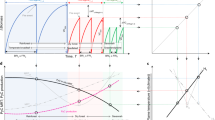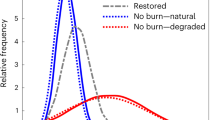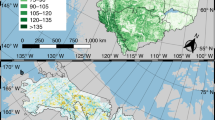Abstract
Wildfires play a key role in the boreal forest carbon cycle1,2, and models suggest that accelerated burning will increase boreal C emissions in the coming century3. However, these predictions may be compromised because brief observational records provide limited constraints to model initial conditions4. We confronted this limitation by using palaeoenvironmental data to drive simulations of long-term C dynamics in the Alaskan boreal forest. Results show that fire was the dominant control on C cycling over the past millennium, with changes in fire frequency accounting for 84% of C stock variability. A recent rise in fire frequency inferred from the palaeorecord5 led to simulated C losses of 1.4 kg C m−2 (12% of ecosystem C stocks) from 1950 to 2006. In stark contrast, a small net C sink of 0.3 kg C m−2 occurred if the past fire regime was assumed to be similar to the modern regime, as is common in models of C dynamics. Although boreal fire regimes are heterogeneous, recent trends6 and future projections7 point to increasing fire activity in response to climate warming throughout the biome. Thus, predictions8 that terrestrial C sinks of northern high latitudes will mitigate rising atmospheric CO2 may be over-optimistic.
This is a preview of subscription content, access via your institution
Access options
Subscribe to this journal
Receive 12 print issues and online access
$209.00 per year
only $17.42 per issue
Buy this article
- Purchase on Springer Link
- Instant access to full article PDF
Prices may be subject to local taxes which are calculated during checkout


Similar content being viewed by others
References
Kasischke, E. S. in Distribution of Forest Ecosystems and the Role of Fire in the North American Boreal Region (eds Kasischke, E. S. & Stocks, B. J.) 19–30 (Springer, 2000).
Bond-Lamberty, B., Peckham, S. D., Ahl, D. E. & Gower, S. T. Fire as the dominant driver of central Canadian boreal forest carbon balance. Nature 450, 89–92 (2007).
Balshi, M. S., McGuire, A. D. & Duffy, P. A. Vulnerability of carbon storage in North American boreal forests to wildfires during the 21st century. Glob. Change Biol. 15, 1491–1510 (2009).
McGuire, A. D. et al. in Land Change Science (eds Gutman, G. et al.) 139–161 (Springer, 2004).
Kelly, R. et al. Recent burning of boreal forests exceeds fire regime limits of the past 10,000 years. Proc. Natl Acad. Sci. USA 110, 13055–13060 (2013).
Kasischke, E. S. & Turetsky, M. R. Recent changes in the fire regime across the North American boreal region—Spatial and temporal patterns of burning across Canada and Alaska. Geophys. Res. Lett. 33, L09703 (2006).
Flannigan, M. D., stocks, B. J., Turetsky, M. R. & Wotton, M. Impacts of climate change on fire activity and fire management in the circumboreal forest. Glob. Change Biol. 15, 549–560 (2009).
Qian, H., Joseph, R. & Zeng, N. Enhanced terrestrial carbon uptake in the northern high latitudes in the 21st century from the coupled carbon cycle climate model intercomparison project model projections. Glob. Change Biol. 16, 641–656 (2010).
IPCC Climate Change 2013: The Physical Science Basis (eds Stocker, T. F. et al.) (Cambridge Univ. Press, 2013).
McGuire, A. D. et al. Sensitivity of the carbon cycle in the Arctic to climate change. Ecol. Monogr. 79, 523–555 (2009).
Grosse, G. et al. Vulnerability of high-latitude soil organic carbon in North America to disturbance. J. Geophys. Res. 116, G00K06 (2011).
Thonicke, K. et al. The influence of vegetation, fire spread and fire behaviour on biomass burning and trace gas emissions: Results from a process-based model. Biogeosciences 7, 1991–2011 (2010).
Kurz, W. A., Stinson, G. & Rampley, G. Could increased boreal forest ecosystem productivity offset carbon losses from increased disturbances? Phil. Trans. R. Soc. B 363, 2259–2268 (2008).
Hayes, D. J. et al. Is the northern high-latitude land-based CO2 sink weakening? Glob. Biogeochem. Cycles 25, GB3018 (2011).
Balshi, M. S. et al. The role of historical fire disturbance in the carbon dynamics of the pan-boreal region: A process-based analysis. J. Geophys. Res. 112, G02029 (2007).
Ali, A. A. et al. Control of the multimillennial wildfire size in boreal North America by spring climatic conditions. Proc. Natl Acad. Sci. USA 109, 20966–20970 (2012).
Higuera, P. E., Brubaker, L. B., Anderson, P. M., Hu, F. S. & Brown, T. A. Vegetation mediated the impacts of postglacial climate change on fire regimes in the south-central Brooks Range, Alaska. Ecol. Monogr. 79, 201–219 (2009).
Kasischke, E. S., Williams, D. & Barry, D. Analysis of the patterns of large fires in the boreal forest region of Alaska. Int. J. Wildland Fire 11, 131–144 (2002).
Jungclaus, J. H. et al. Climate and carbon-cycle variability over the last millennium. Clim. Past 6, 723–737 (2010).
Schmidt, G. A. et al. Climate forcing reconstructions for use in PMIP simulations of the last millennium (v1.0). Geosci. Model Dev. 4, 33–45 (2011).
Hu, F. S., Ito, E., Brown, T. A., Curry, B. B. & Engstrom, D. R. Pronounced climatic variations in Alaska during the last two millennia. Proc. Natl Acad. Sci. USA 98, 10552–10556 (2001).
O’Neill, K. P., Kasischke, E. S. & Richter, D. D. Seasonal and decadal patterns of soil carbon uptake and emission along an age sequence of burned black spruce stands in interior Alaska. J. Geophys. Res. 108(D1), 8155 (2003).
Genet, H. et al. Modeling the effects of fire severity and climate warming on active layer thickness and soil carbon storage of black spruce forests across the landscape in interior Alaska. Environ. Res. Lett. 8, 045016 (2013).
Kurz, W. A. et al. CBM-CFS3: A model of carbon-dynamics in forestry and land-use change implementing IPCC standards. Ecol. Model. 220, 480–504 (2009).
Daniau, A.-L. et al. Predictability of biomass burning in response to climate changes. Glob. Biogeochem. Cycles 26, GB4007 (2012).
Hugelius, G. et al. The Northern Circumpolar Soil Carbon Database: Spatially distributed datasets of soil coverage and soil carbon storage in the northern permafrost regions. Earth Syst. Sci. Data 5, 707–733 (2012).
Luo, Y. et al. Ecological forecasting and data assimilation in a data-rich era. Ecol. Appl. 21, 1429–1442 (2011).
Mitchell, T. D. & Jones, P. D. An improved method of constructing a database of monthly climate observations and associated high-resolution grids. Int. J. Climatol. 25, 693–712 (2005).
Gallant, A. L., Binnian, E. F., Omernik, J. M. & Shasby, M. B. Ecoregions of Alaska (United States Government Printing Office, 1995).
Zhuang, Q. et al. Modeling soil thermal and carbon dynamics of a fire chronosequence in interior Alaska. J. Geophys. Res. 107(D1), 8147 (2003).
Yi, S. et al. Interactions between soil thermal and hydrological dynamics in the response of Alaska ecosystems to fire disturbance. J. Geophys. Res. 114, G02015 (2009).
Yi, S. et al. A dynamic organic soil biogeochemical model for simulating the effects of wildfire on soil environmental conditions and carbon dynamics of black spruce forests. J. Geophys. Res. 115, G04015 (2010).
Yuan, F. M. et al. Assessment of boreal forest historical C dynamics in the Yukon River Basin: Relative roles of warming and fire regime change. Ecol. Appl. 22, 2091–2109 (2012).
Goulden, M. L. et al. Patterns of NPP, GPP, respiration, and NEP during boreal forest succession. Glob. Change Biol. 17, 855–871 (2011).
Bond-Lamberty, B., Wang, C. & Gower, S. Net primary production and net ecosystem production of a boreal black spruce wildfire chronosequence. Glob. Change Biol. 10, 473–487 (2004).
Viereck, L. A. Wildfire in the taiga of Alaska. Quat. Res. 3, 465–495 (1973).
Johnson, K. D. et al. Soil carbon distribution in Alaska in relation to soil-forming factors. Geoderma 167–168, 71–84 (2011).
Malone, T., Liang, J. & Packee, E. C. Cooperative Alaska Forest Inventory 1–50 (USDA, 2009).
Yarie, J., Kane, E. & Mack, M. C. Aboveground biomass equations for the trees of interior Alaska Bulletin 115 (US Forest Service, 2007).
Alexander, H. D., Mack, M. C., Goetz, S., Beck, P. S. A. & Belshe, E. F. Implications of increased deciduous cover on stand structure and aboveground carbon pools of Alaskan boreal forests. Ecosphere 3, 45 (2012).
Turetsky, M. R. et al. Recent acceleration of biomass burning and carbon losses in Alaskan forests and peatlands. Nature Geosci. 4, 27–31 (2010).
Walsh, J. E., Chapman, W. L., Romanovsky, V., Christensen, J. H. & Stendel, M. Global climate model performance over Alaska and Greenland. J. Clim. 21, 6156–6174 (2008).
Schmidt, G. A. et al. Present-day atmospheric simulations using GISS ModelE: Comparison to in situ, satellite, and reanalysis data. J. Clim. 19, 153–192 (2006).
Gent, P. R. et al. The community climate system model version 4. J. Clim. 24, 4973–4991 (2011).
Crowley, T. J. et al. Volcanism and the little ice age. PAGES News 16, 22–23 (2008).
Gao, C., Robock, A. & Ammann, C. Volcanic forcing of climate over the past 1500 years: An improved ice core-based index for climate models. J. Geophys. Res. Atmos. 113, D23111 (2008).
Steinhilber, F., Beer, J. & Frohlich, C. Total solar irradiance during the Holocene. Geophys. Res. Lett. 36, 9–12 (2009).
Vieira, L. E. A. & Solanki, S. Evolution of the solar magnetic flux on time scales of years to millenia. Astron. Astrophys. 509, A100 (2010).
Acknowledgements
We gratefully acknowledge comments on this work from M. L. Chipman, E. S. Euskirchen, Y. Zhang, D. Devotta, M. Urban and M. Fernandez, and technical support from J. Jungclaus and D. Rice. This work was supported by National Science Foundation (NSF) Grants ARC-0612366 and ARC-1023477 (F.S.H.), by University of Illinois funding from a Graduate College Dissertation Completion Fellowship, the School of Integrative Biology Enhancement Fund, and the Department of Plant Biology Graduate Research Enhancement Fund (R.K.), and by grants from the US Geological Survey, the US Fish and Wildlife Service, the National Science Foundation, and the Department of Defense (A.D.M. and H.G.). Any use of trade, firm, or product names is for descriptive purposes only and does not imply endorsement by the US Government.
Author information
Authors and Affiliations
Contributions
R.K. conducted the analysis with assistance from H.G. All authors contributed in designing the study, interpreting results, and preparing the manuscript.
Corresponding authors
Ethics declarations
Competing interests
The authors declare no competing financial interests.
Supplementary information
Rights and permissions
About this article
Cite this article
Kelly, R., Genet, H., McGuire, A. et al. Palaeodata-informed modelling of large carbon losses from recent burning of boreal forests. Nature Clim Change 6, 79–82 (2016). https://doi.org/10.1038/nclimate2832
Received:
Accepted:
Published:
Issue Date:
DOI: https://doi.org/10.1038/nclimate2832
This article is cited by
-
Wildfire precursors show complementary predictability in different timescales
Nature Communications (2023)
-
Estimation of actual carbon dioxide removal in burned forests using satellite data: A case study in South Korea
Journal of Mountain Science (2023)
-
Climate-driven decoupling of wetland and upland biomass trends on the mid-Atlantic coast
Nature Geoscience (2022)
-
Drivers of wildfire carbon emissions
Nature Climate Change (2020)
-
Recent Advances and Remaining Uncertainties in Resolving Past and Future Climate Effects on Global Fire Activity
Current Climate Change Reports (2016)



